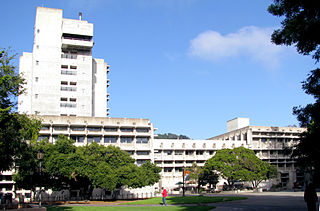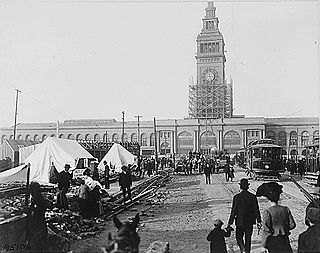Related Research Articles

Julia Morgan was an American architect and engineer. She designed more than 700 buildings in California during a long and prolific career. She is best known for her work on Hearst Castle in San Simeon, California.

Arthur Brown Jr. was an American architect, based in San Francisco and designer of many of its landmarks. He is known for his work with John Bakewell Jr. as Bakewell and Brown, along with later works after the partnership dissolved in 1927.

Bernard Ralph Maybeck was an American architect in the Arts and Crafts Movement of the early 20th century. He worked primarily in the San Francisco Bay Area, designing public buildings, including the Palace of Fine Arts in San Francisco, and also private houses, especially in Berkeley, where he lived and taught at the University of California. A number of his works are listed on the National Register of Historic Places.

The College of Environmental Design, also known as the Berkeley CED, or simply CED, is one of fifteen schools and colleges at the University of California, Berkeley. The school is located in Bauer Wurster Hall on the southeast corner of the main UC Berkeley campus. It is composed of three departments: the Department of Architecture, the Department of City and Regional Planning, and the Department of Landscape Architecture and Environmental Planning.

Joseph Esherick was an American architect. He is known for his work in Sea Ranch, California and in the San Francisco Bay Area.

California bungalow is an alternative name for the American Craftsman style of residential architecture, when it was applied to small-to-medium-sized homes rather than the large "ultimate bungalow" houses of designers like Greene and Greene. California bungalows became popular in suburban neighborhoods across the United States, and to varying extents elsewhere, from around 1910 to 1939.

John Galen Howard was an American architect and educator who began his career in New York before moving to California. He was the principal architect at several firms in both states and employed Julia Morgan early in her architectural career.

Willis Jefferson Polk was an American architect, best known for his work in San Francisco, California. For ten years, he was the West Coast representative of D.H. Burnham & Company. In 1915, Polk oversaw the architectural committee for the Panama–Pacific International Exposition (PPIE).

William Wilson Wurster was an American architect and architectural teacher at the University of California, Berkeley, and at the Massachusetts Institute of Technology, best known for his residential designs in California.

The Swedenborgian Church is a historic church complex at 2107 Lyon Street in the Pacific Heights neighborhood of San Francisco, California. Built in 1895 for a Swedenborgian congregation, it is considered one of California's earliest pure Arts and Crafts buildings, with design contributions by A. C. Schweinfurth, A. Page Brown, Bernard Maybeck, William Keith, and Bruce Porter. It was designated a National Historic Landmark in 2004.

Charles Augustus Keeler was an American author, poet, ornithologist and advocate for the arts, particularly architecture.
Henrik Helkand Bull was a founder of Bull Stockwell Allen / BSA Architects in San Francisco in 1967.
Esherick Homsey Dodge and Davis is a United States–based architecture, interiors, planning and urban design firm. EHDD is ranked among the top 20 architecture firms in the San Francisco Bay Area where it is headquartered, and is recognized for collaboration, commitment to innovation and investigation, and responsiveness to location, light, and climate.

A. C. Schweinfurth (1864–1900), born Albert Cicero Schweinfurth, was an American architect. He is associated with the First Bay Tradition, an architectural style from the period of the 1880s to early 1920s.
The Second Bay Tradition is an architectural style from the period of 1928 through 1942 that was rooted in San Francisco and the greater Bay Area. Also referred to as "redwood post and beam", the style is characterized by a rustic, woodsy philosophy and features sleek lines and machine aesthetic. Associated with European Modernism, the architects Gardner Dailey, William Merchant, Henry Hill, and William Wurster designed in the style. A repository of drawings and specifications from the tradition are housed at the Environmental Design Archives at the University of California, Berkeley.

A. Page Brown, born Arthur Page Brown, was an American architect known for buildings that incorporated classical styles in the Beaux-Arts manner. Having first worked in the office of McKim, Mead and White in New York City in 1879, he established his own firm in 1884 and hired a young Willis Polk as a draftsman. In 1889 Brown moved his office to San Francisco, California to take advantage of the city's growth.

Lilian "Lillie" Belle Bridgman (1866–1948) was an American architect, educator, writer, and scientist. After working first as a science teacher and writer, she changed her profession in mid-life and followed her dream of becoming an architect.

Esther Frances Born was an American architect, author and architectural photographer who lived and worked in the San Francisco Bay Area, New York, and Mexico. With her husband, Ernest Born, she wrote The New Architecture in Mexico, which also includes an article on the painting and sculpture by Justino Fernández. She traveled in Mexico for 10 months, photographing and drawing historic and modern buildings, ultimately attracting global attention to the dawn of Mexico's modern architecture. Working mostly behind the scenes, she was integral to the success of the Ernest Born architecture firm.
John Hudson Thomas (1878—1945) was an American architect, who practiced in Northern California.

The Unitarian Universalist Church of Berkeley (UUCB) was founded as the First Unitarian Church of Berkeley in Berkeley, California in 1891 and moved to Kensington, California in 1961. It is one of the oldest and largest Unitarian Universalist churches on the West Coast and has had many distinguished members, including numerous professors at the University of California, Berkeley. It is highly regarded for its music program as well as its series of renowned ministers and its many avenues for spiritual growth, learning, and social action.
References
- ↑ According to Freudenheim and Sussman, per National Register of Historic Places Registration: Jobs Peak Ranch, a year 2000 NRHP nomination of a work by Nevada architect Russell Mills.
- 1 2 3 Brown, Mary (January 12, 2011). "San Francisco Modern Architecture and Landscape Design 1935-1970 Historic Context Statement" (PDF). San Francisco City and County Planning Department. p. 82. Retrieved 7 September 2021.
- ↑ "About". College of Environmental Design Archives. University of California, Berkeley. Retrieved 7 September 2021.
- ↑ Thompson, Elisabeth Kendall (1951). "The Early Domestic Architecture of the San Francisco Bay Region". Journal of the Society of Architectural Historians. 10 (3): 15–21. doi:10.2307/987446. JSTOR 987446.
- ↑ "The Early Builders (1853-1863)". Russian Hill Neighbors. Retrieved 25 July 2019.
- ↑ Longstreth, Richard W. (1998) [1983]. On the Edge of the World: Four Architects in San Francisco at the Turn of the Century. University of California Press. pp. 6–7. ISBN 978-0-520-21415-6 . Retrieved 16 August 2011.